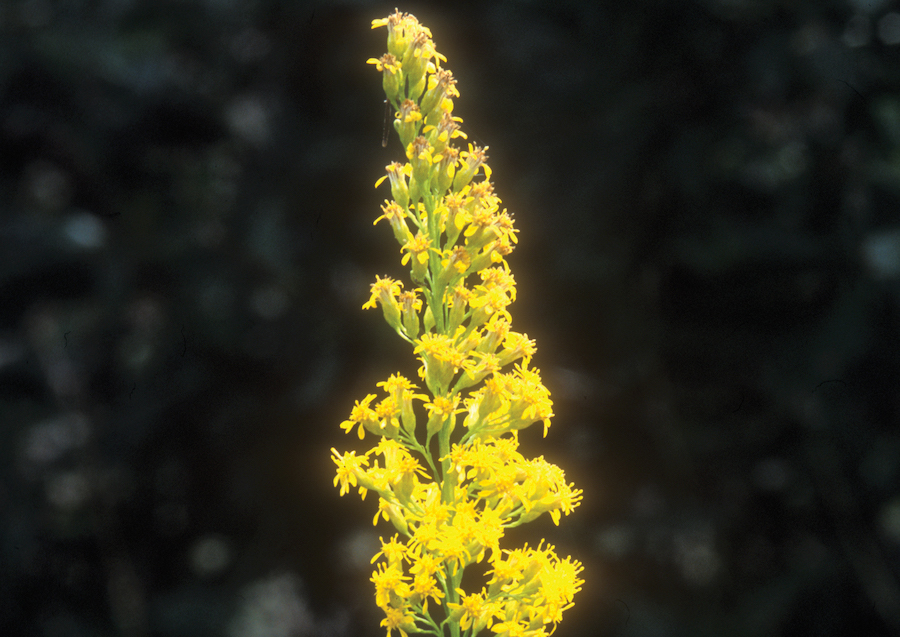Native Wildflowers of Florida’s Panhandle
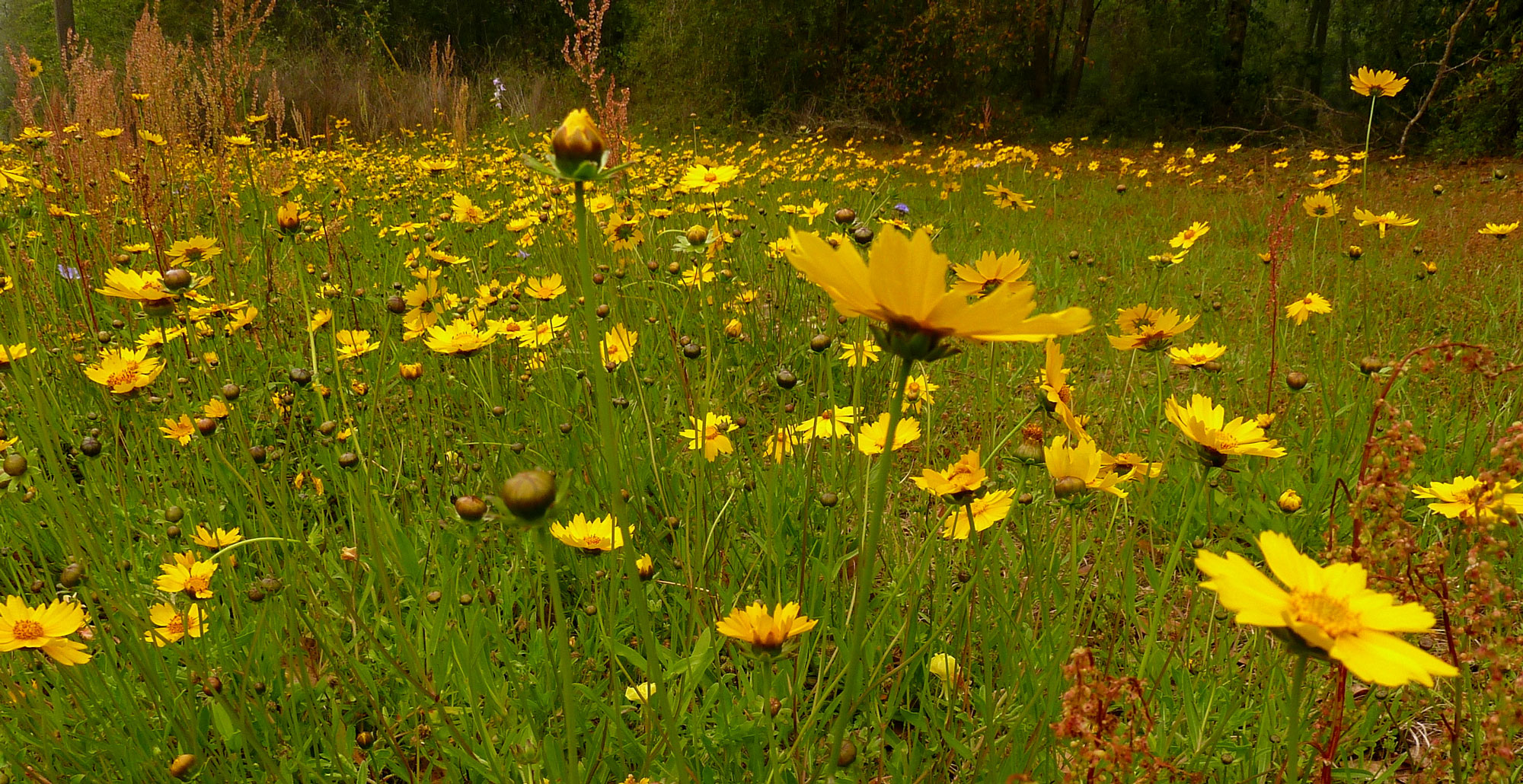
Pictured: Lanceleaf tickseed (Coreopsis lanceolata) by Eleanor Dietrich.
Celebrating the Land of Flowers
In 1513, Spanish explorer Juan Ponce de Leon sighted land near what is now St. Augustine on Easter Sunday. He named it La Florida — “land of flowers” — in honor of Spain’s Easter celebration. The land’s abundant spring wildflowers could also have influenced the name choice.
More than 500 years later, the number of wildflowers that thrive in wild places and along roadsides and trails has dwindled. However, many organizations and agencies now are working to preserve wildflowers, especially along roadsides.
Efforts to beautify roadsides with wildflowers began with local garden and civic clubs. A statewide effort took root in the 1960s when motorists gave rave reviews to non-native Crimson clover planted by the Florida Department of Transportation south of Tallahassee.
Because native wildflowers are adapted to Florida’s climate, soils, insects and diseases, roadside planting programs gradually have grown to include more of them. Naturally occurring wildflowers also are being managed with mowing practices that keep them flourishing. These efforts have been supported by:
- The Florida State Wildflower license plate and the Florida Wildflower Foundation, which provide funds for native wildflower education, planting and research.
- The Florida Department of Transportation’s Wildflower Management Program, which was created in 2004 in response to increased interest and enthusiasm for roadside wildflowers.
- The development of a native wildflower seed-production industry, which began in the late 1990s.
- The Florida Federation of Garden Clubs’ Paths of Sunshine Awards, which recognize and promote the conservation, restoration, management and planting of native plants and wildflowers on Florida roadsides.
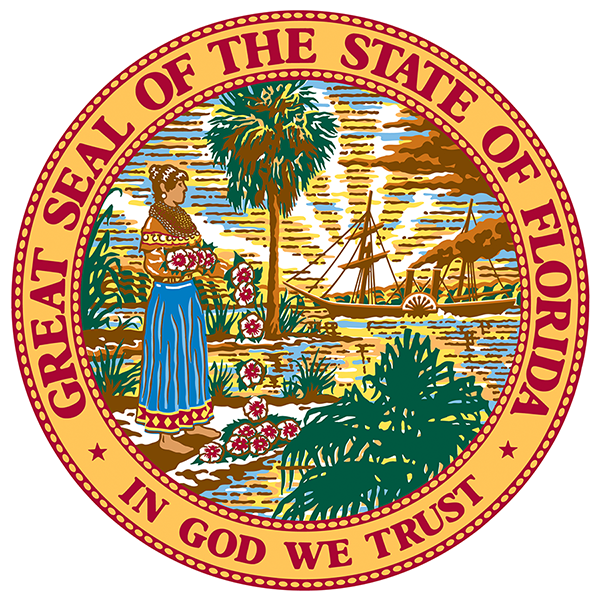
The historic significance of native wildflowers is displayed in Florida’s state seal.
The Florida Panhandle – a great place to see native wildflowers
The Panhandle’s plentiful public lands and rural places make it a wonderful place to see wildflowers. Natural lands include the Apalachicola National Forest, a number of state parks, forests and wildlife management areas, large natural areas surrounding two Air Force bases, and Northwest Florida Water Management District lands. Private conservation organizations such as Tall Timbers Research Station and Land Conservancy and The Nature Conservancy also own and/or manage substantial acreage.
Most of this land is routinely managed by prescribed fire, which promotes the growth of native wildflowers and grasses. Soil characteristics also are important. Many wildflowers thrive in the moist, slightly acidic fine-sand soils abundant in the Panhandle. Cool winters, warm summers and plentiful rainfall help support wildflower growth.
Wildflower viewing tips
- Spring and fall typically are the best seasons to view showy stands of wildflowers, but check moist areas in the summer for flowers such as Meadowbeauty, Hibiscus, and Rosegentian.
- The best places to see showy wildflowers are rural areas (especially moist ones), recently burned natural areas and infrequently mowed roadsides. Spread the beauty — send your photos to Photos@FlaWildflowers.org.
- Click it, don’t pick it. Picking flowers reduces a species’ ability to sustain itself. If you want to preserve your memories, take a picture — it will last longer.
- Picking the flowers of endangered or threatened species is illegal. (See Florida Statute 581.185 Preservation of native flora of Florida.)
- Stopping on the road or shoulder to view or photograph wildflowers can be hazardous to you and other motorists. Many Panhandle roadsides have pullouts where you can park to explore the roadside. Use caution when on foot, and stay well away from the pavement.
- For more information on Florida’s native wildflowers, check out our extensive library of native plant profiles. Click here to learn how the Foundation is helping to keep roadsides blooming.
Get involved
Conserve, preserve, protect
- You can help preserve native wildflowers on roadsides by urging your county to adopt wildflower-friendly mowing practices. Visit the Florida Wildflower Foundation website to download a county resolution to present.
- Support work for wildflowers by purchasing a State Wildflower license plate or by making a donation to the Florida Wildflower Foundation. Visit FlaWildflowers.org to learn more.
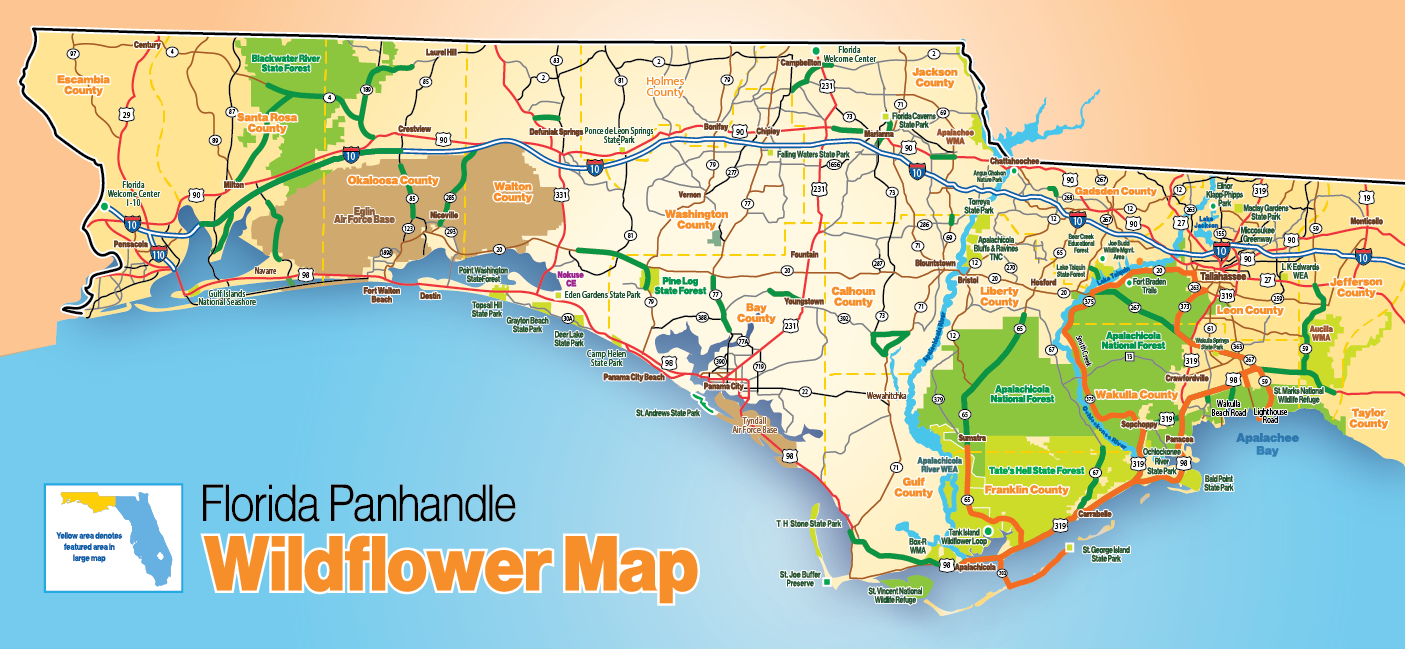

This map features wildflower viewing areas that are managed for naturally occurring wildflowers. There are many other roadsides where wildflowers flourish. Wildflowers frequently bloom in spring along Interstate 10 and in spring and fall along many rural roads.
Learn more at VisitFlorida.com, FloridaStateParks.org and MyFWC.org/recreation
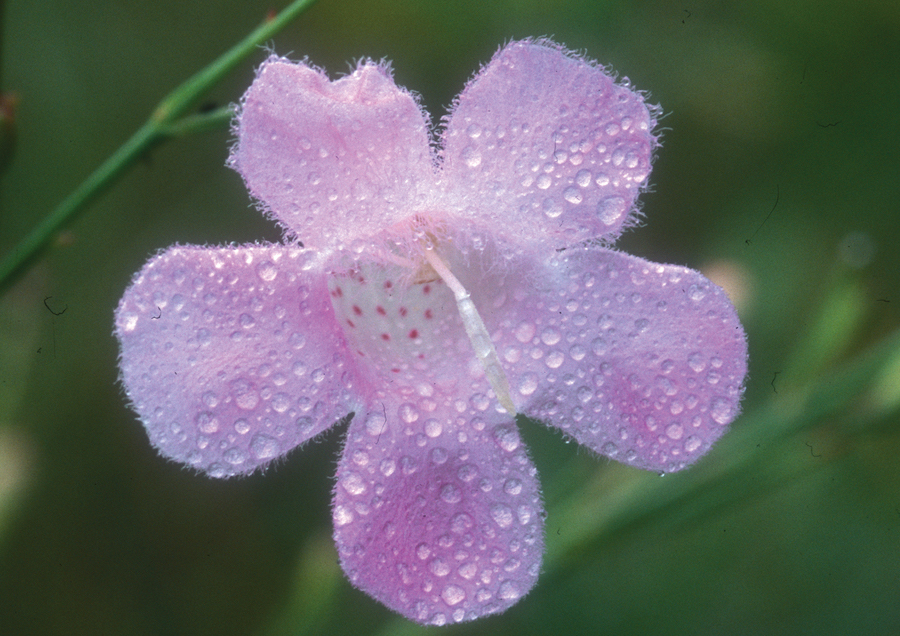
The attractive lavender or purple flowers of our several false foxgloves (Agalinis spp.) are harbingers of autumn. Most begin to flower in late summer but are at their best in September and October. About a dozen species occur in our region, many of which are difficult to distinguish from each other. Summer, Fall
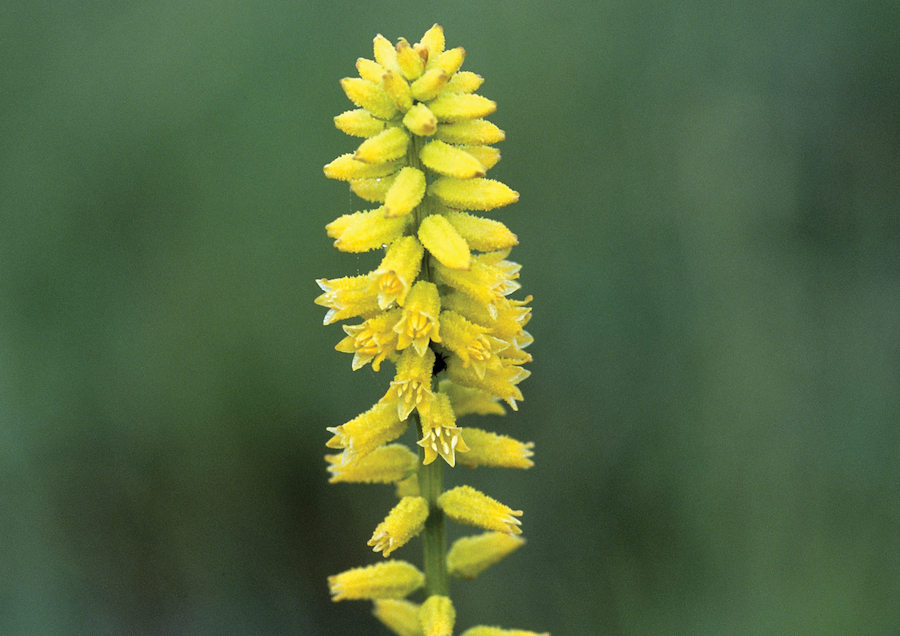
Yellow colicroot (Aletris lutea) can dominate moist to wet roadsides during its mid- to late spring flowering period. The stiffly erect, 3’ stem arises from a flattened whorl of ground-hugging leaves and is terminated by a spikelike inflorescence of bright yellow, tubular flowers. Spring
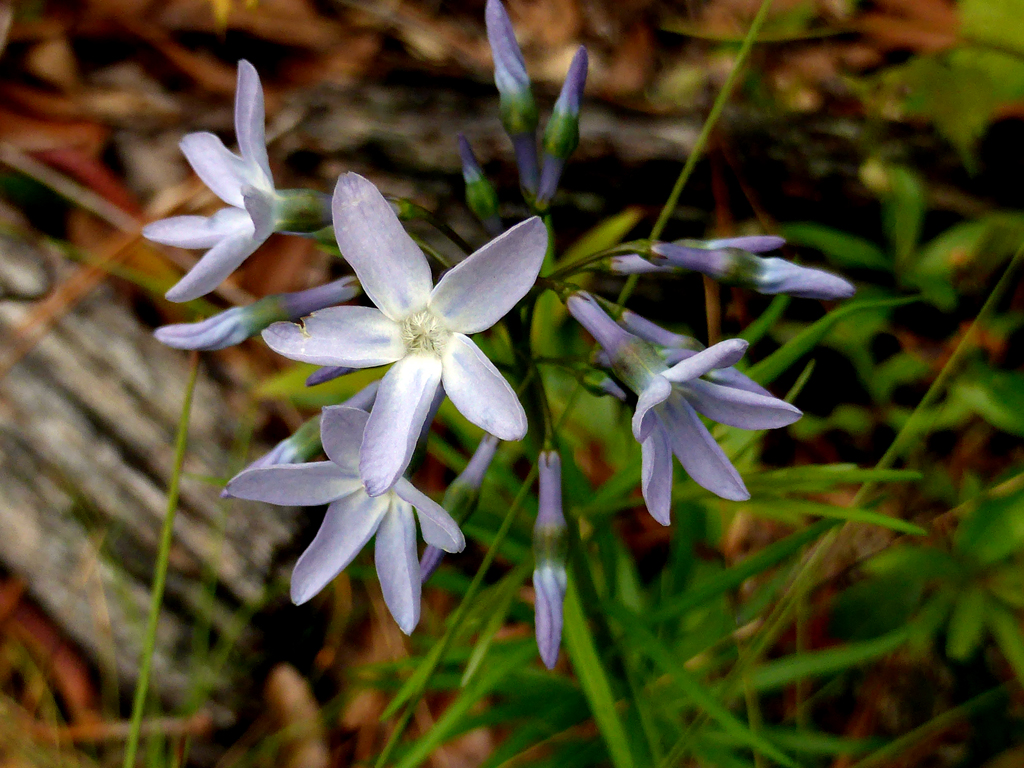
Two species of bluestar occur in the Panhandle: Fringed bluestar (Amsonia ciliata) (pictured) occurs along the backslope of dry, sandy roadsides. Eastern bluestar (A. tabernaemontana) occurs in wet woodlands. The stem is about 2’ tall with very narrow leaves. It is topped by a showy cluster of pale blue to bluish-white star-shaped flowers. Spring
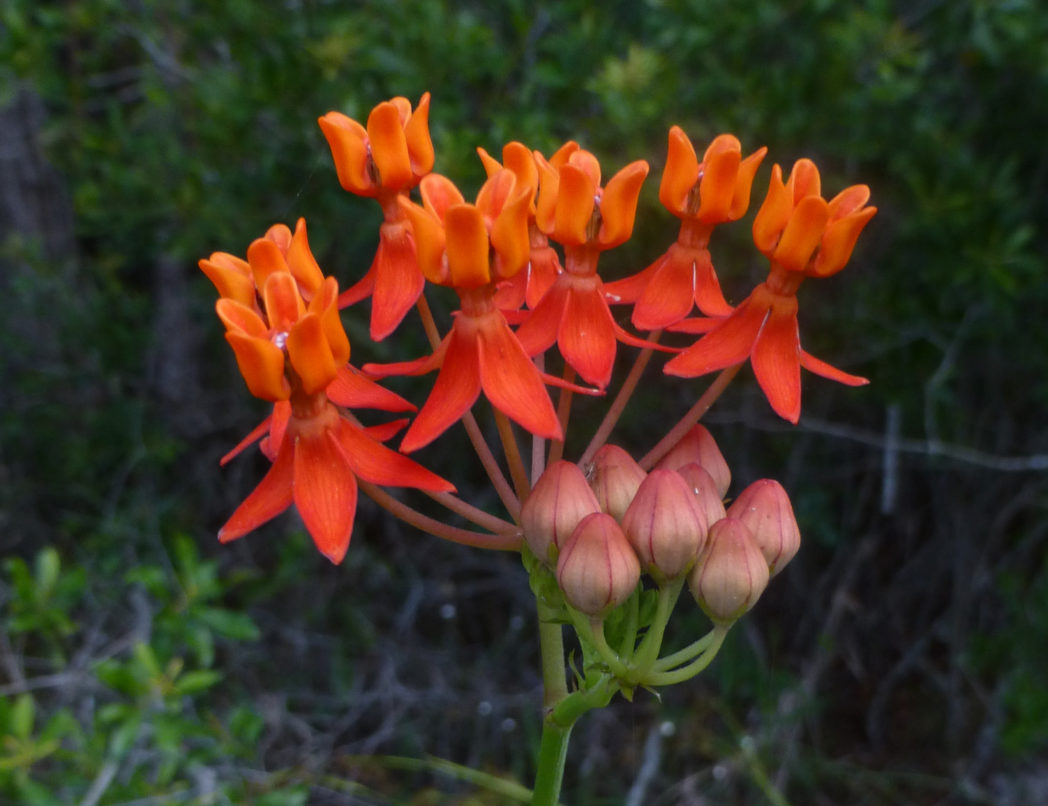
Milkweeds are most easily recognized by their unique flowers and best known for their attractiveness to butterflies. Some are low-growing; others tall and conspicuous. Flower color ranges from white to lavender, green, yellow, or bright orange-red. Lanceleaf milkweed (Aslcepias lanceolata) can be 3-4’ tall, which makes it a conspicuous component of wet roadside ditches. Spring, Summer
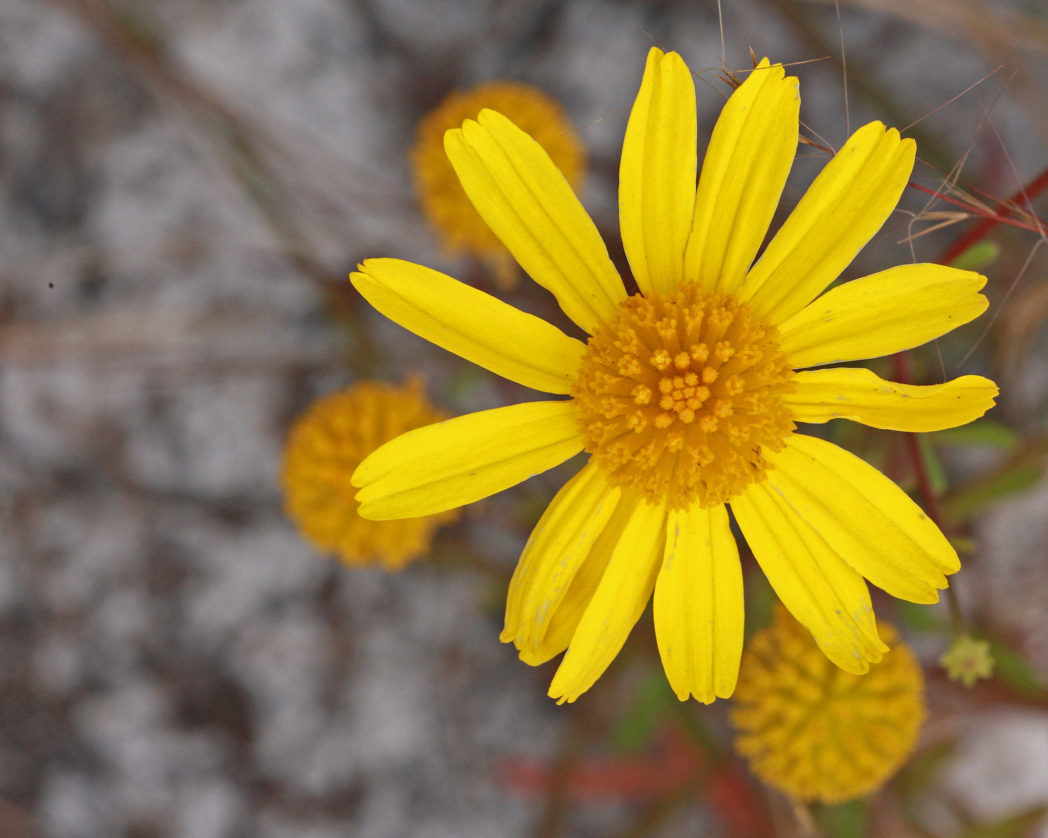
Honeycombhead (Balduina spp.) usually occurs in large showy populations, with thousands of plants stretching across the wet savannas of the Apalachicola National Forest. Two species occur in the Panhandle, including one that prefers dry, sandy roadsides. Fall
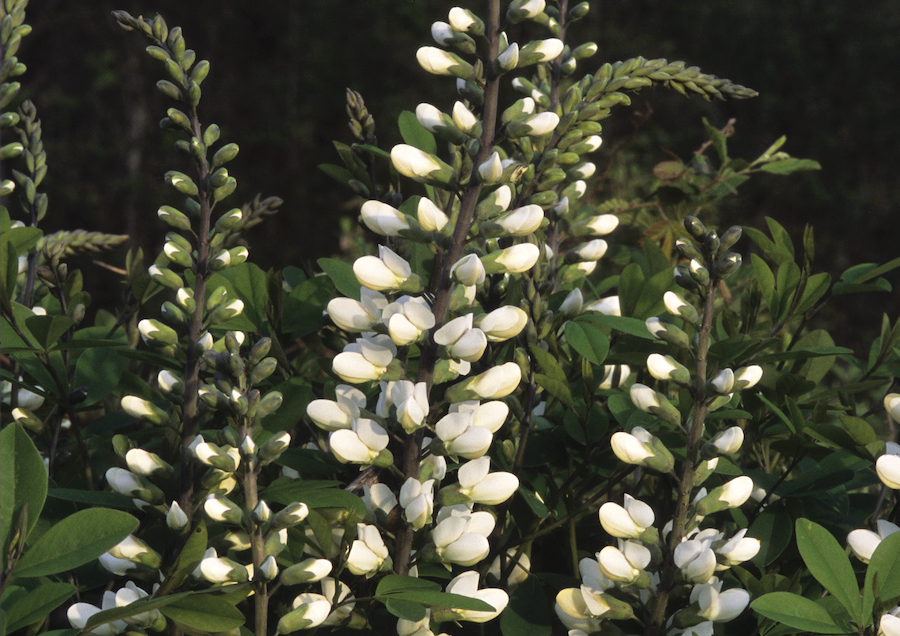
White wild indigo (Baptisia alba) is a large, shrubby bean that stands 3’–4’ tall. In early to mid-spring it produces numerous tall, showy racemes of creamy white pea flowers that are unmistakable. It prefers moist, open roadsides in full sun. Mid-Spring
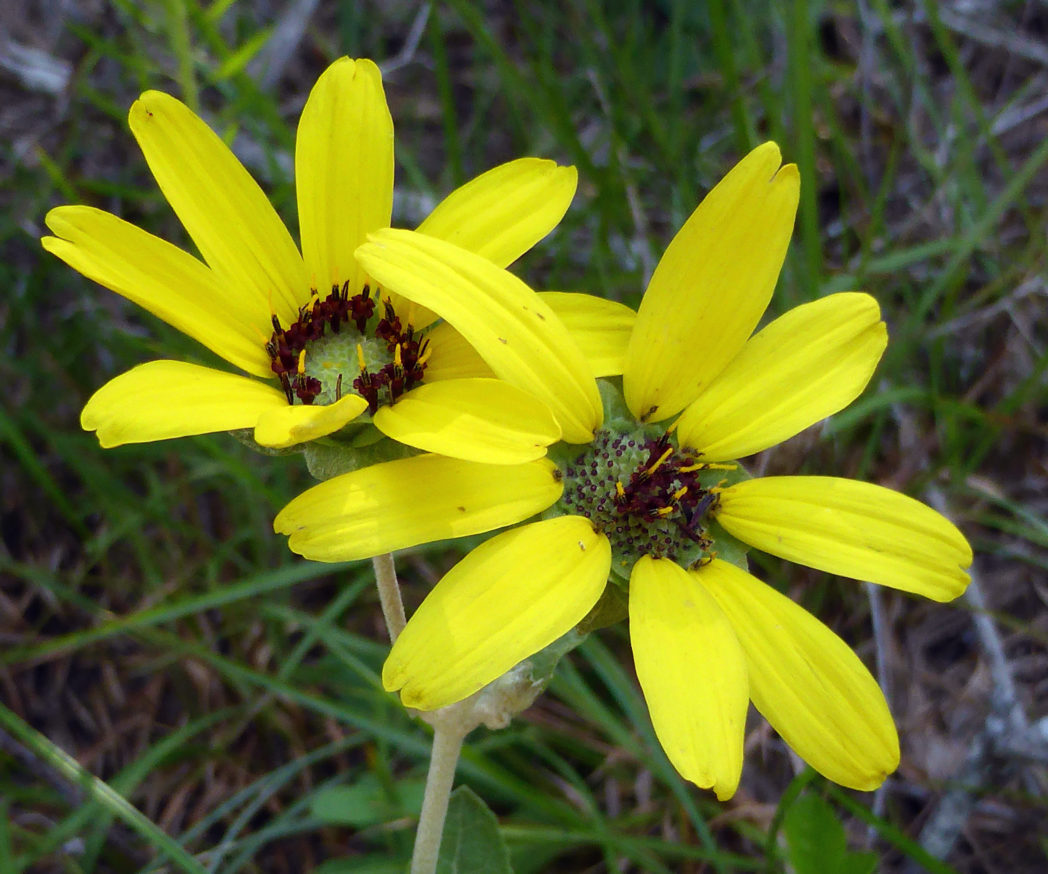
Soft greeneyes (Berlandiera pumila) takes its name from its flowerheads, which have a round green disk at the center of eight bright yellow rays. The stem is 8”–32” tall with conspicuous 4” leaves. It is most often seen on dry, open, sandy roadsides. Disk flowers have a chocolate aroma when open. Spring, Summer
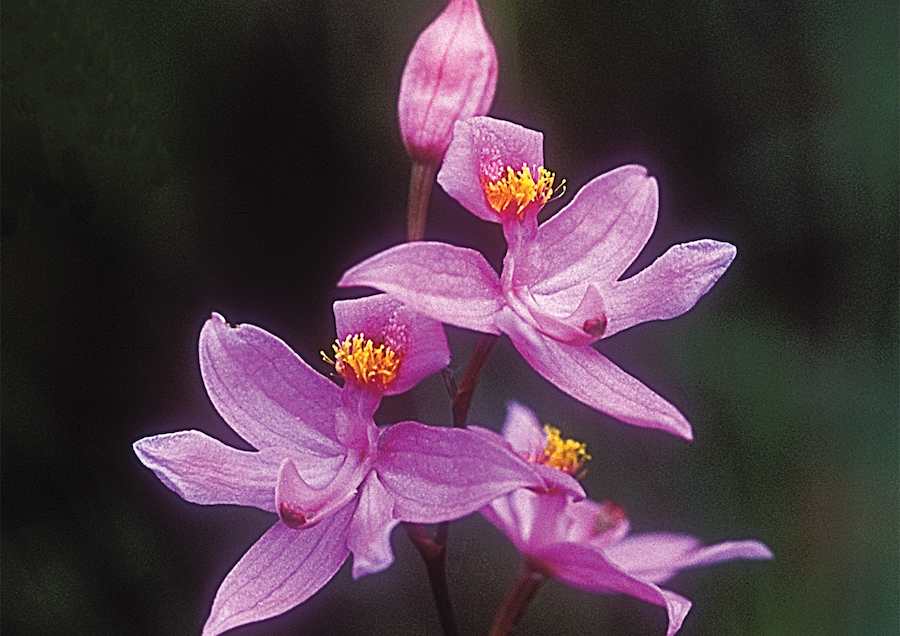
Several species of grasspink orchids (Calopogon spp.) occur along the routes recommended here. All have “upside-down” flowers, with the lip petal pointing upward rather than downward. The patch of showy hairs at the top of the lip resembles stamens and are an adaptation designed to attract bees and other pollinators. Pictured: Bearded grasspink orchid (Calopogon barbatus). Spring
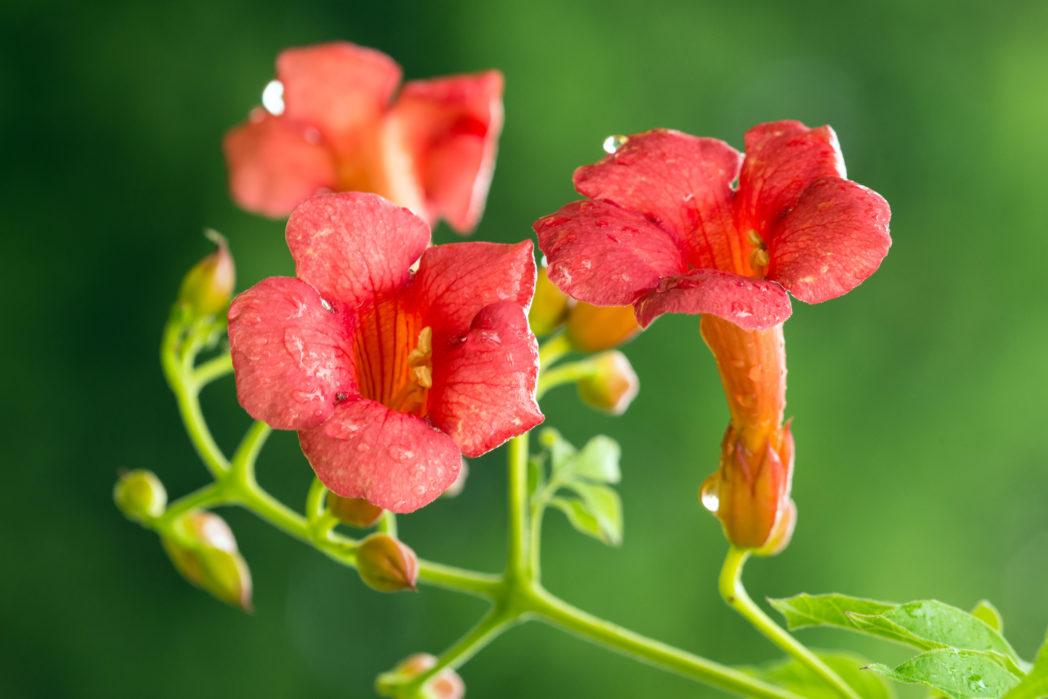
The tubular orange-red flowers of Trumpet creeper (Campsis radicans) make their first appearance in late spring but continue into summer. This is a high-climbing woody vine with lacy leaves. Look for it scaling trees and shrubs just off the road shoulder. Spring, Summer
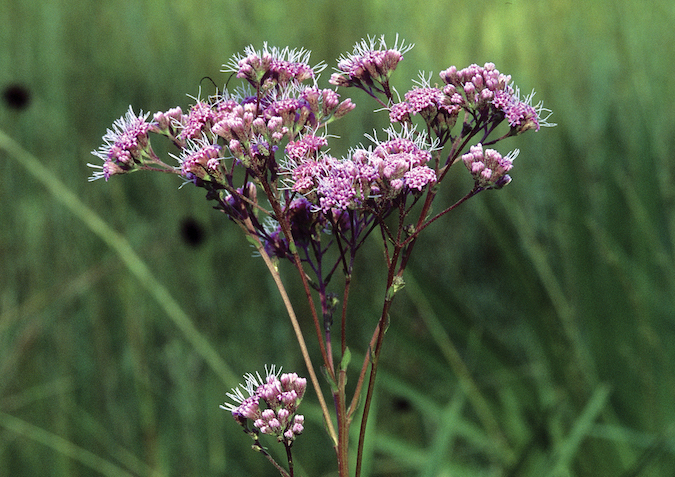
Vanillaleaf (Carphephorus odoratissimus) is a single-stemmed, fall-blooming herb that ranges from 1’–4’ tall and has numerous densely packed heads of tiny purple flowers. It typically occurs in large, conspicuous colonies that are especially notable when flowers are present. It is known as Vanillaleaf because of the scent of its leaves. Fall
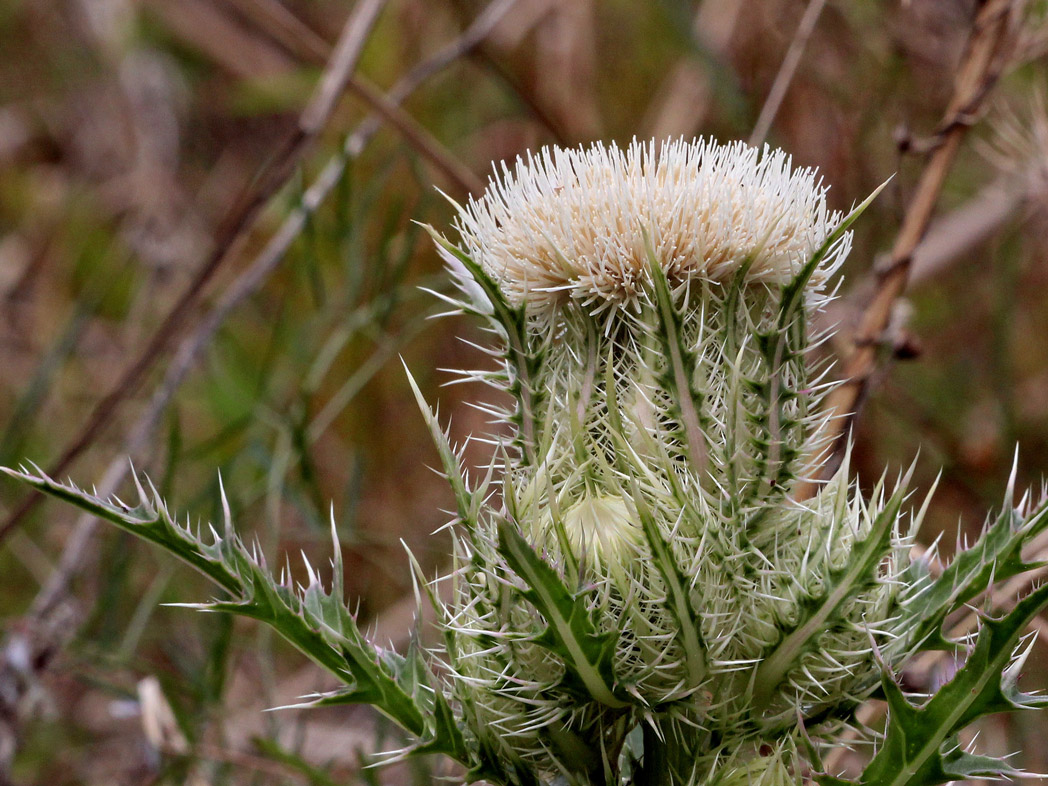
The several thistles (Cirsium spp.) that occur along Florida’s roadsides are among our most distinctive wildflowers. Although their flower structure is similar, flower color can range from yellow to pinkish or purplish. Purple thistle (Cirsium horridulum), pictured, is characterized by a treacherous nest of prickly, leaflike bracts under the flower head. Spring, Summer
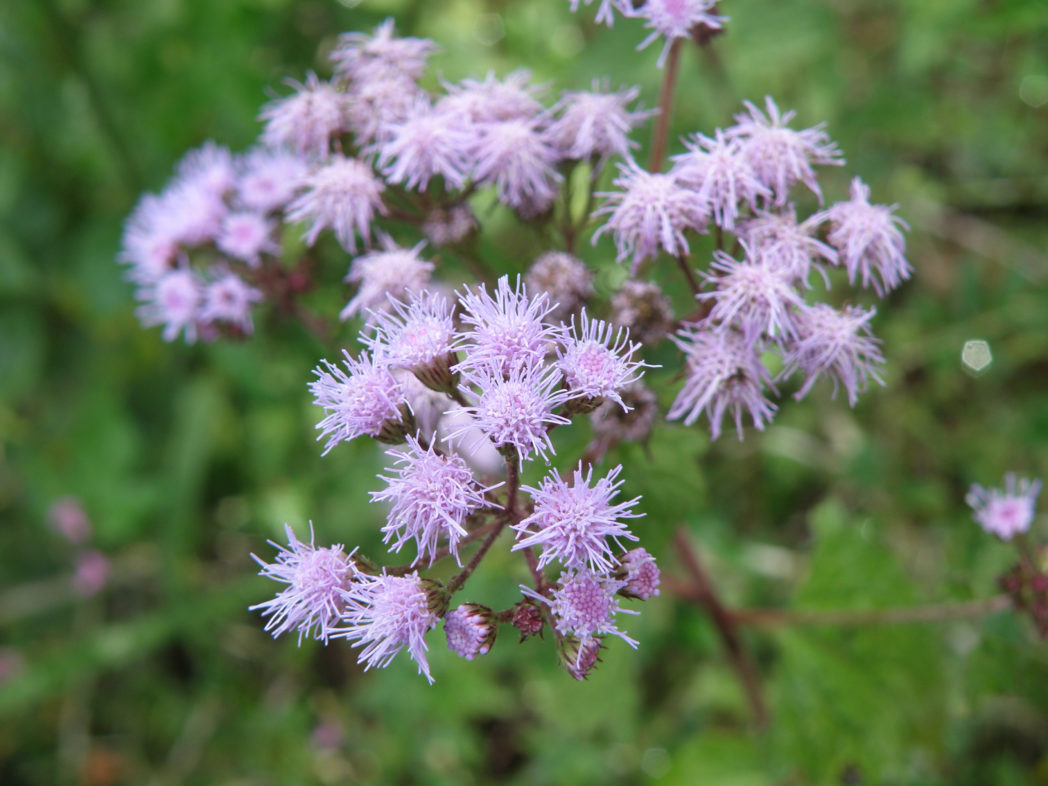
Blue mistflower (Conoclinium coelestinum) is a sure sign that autumn has arrived or is certainly not far away. Spreading rapidly by underground runners, this aggressive herbaceous perennial forms large colonies of 1’–3’ tall plants. The numerous compact heads of deep blue or purple flowers add significant charm to October roadsides. Fall
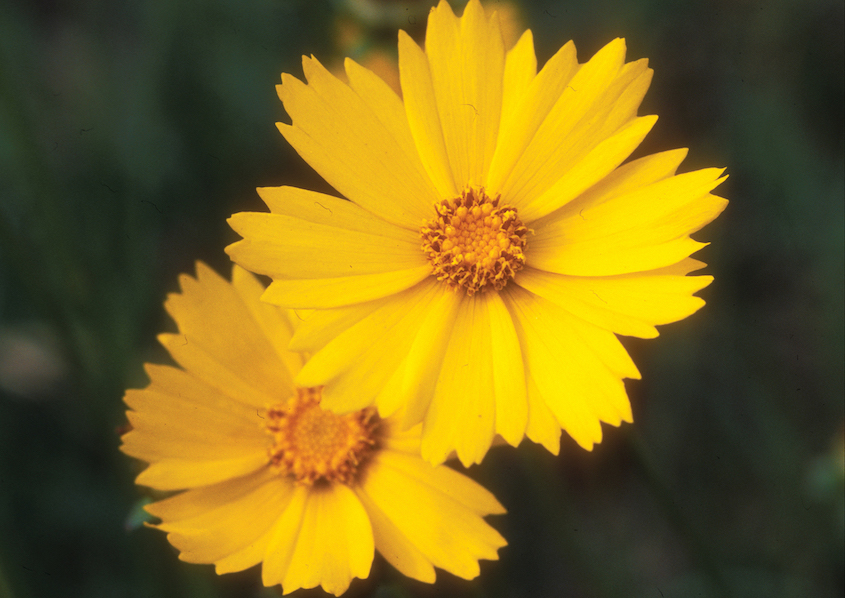
Coreopsis is Florida’s state wildflower. Sixteen species occur in the state. Most, like this Lanceleaf tickseed (Coreopsis lanceolata), have yellow disk flowers with ray flowers notched at the tips. Lanceleaf tickseed is one of Florida’s more common, showy spring wildflowers. Spring, Summer, Fall
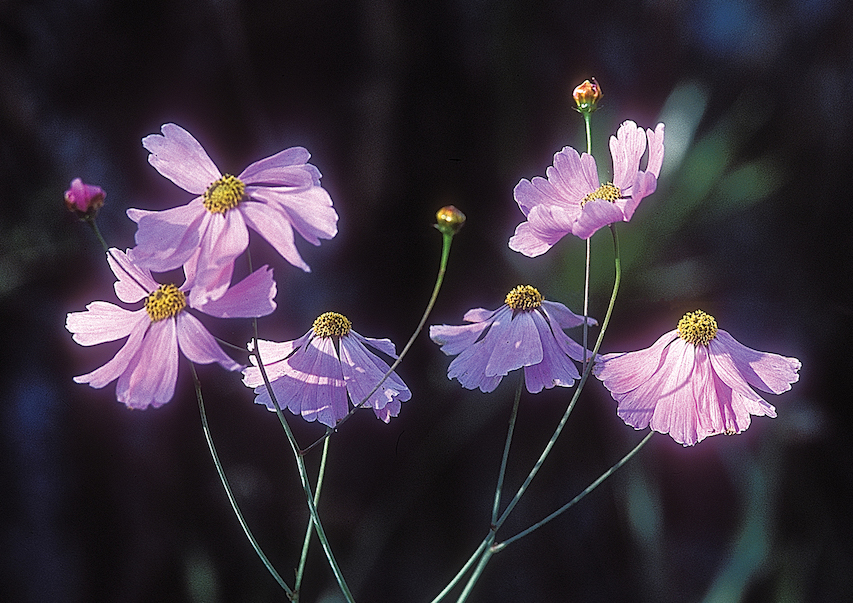
Pink tickseed (Coreopsis nudata), our only pink-flowered Coreopsis, is found mostly in the Panhandle. Plants can grow to 5’ tall and often occur in large showy colonies, with numerous flowerheads adding a conspicuous splash of color to wet ditches. Pink tickseed is common along several of this brochure’s recommended routes. Spring
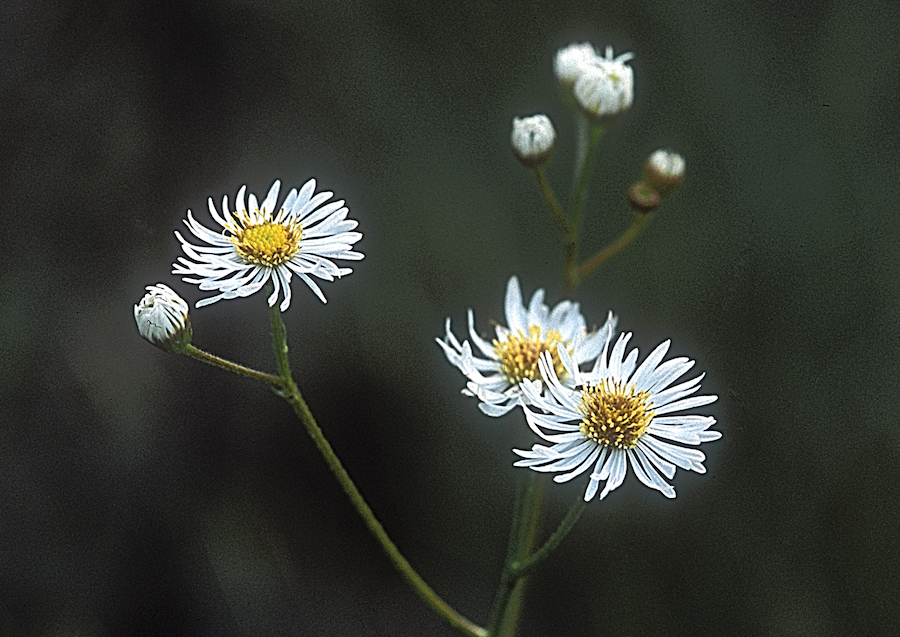
The daisy fleabanes (Erigeron spp.) are among the most common roadside wildflowers. They are easily recognized by their daisylike flowerheads with a dark center surrounded by numerous small, laterally spreading rays. At least four species occur in the Panhandle. Early whitetop fleabane (Erigeron vernus), pictured, blooms in spring. Spring, Summer
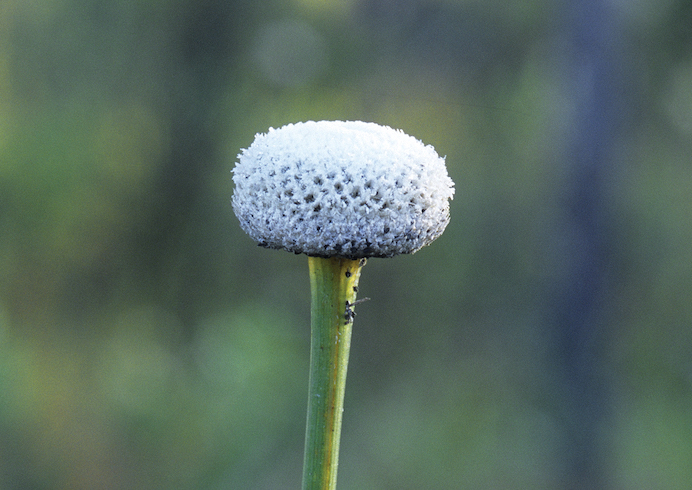
Tenangle pipewort (Eriocaulon decangulare) has an erect, 1’–3’ tall arrow-straight stem, topped by a buttonlike cluster of creamy-white flowers that suggest the decorative pin used to hold a lady’s hat to her head. These clump-forming perennials are denizens of wet roadside ditches and often occur in large, conspicuous colonies. Spring, Summer, Fall
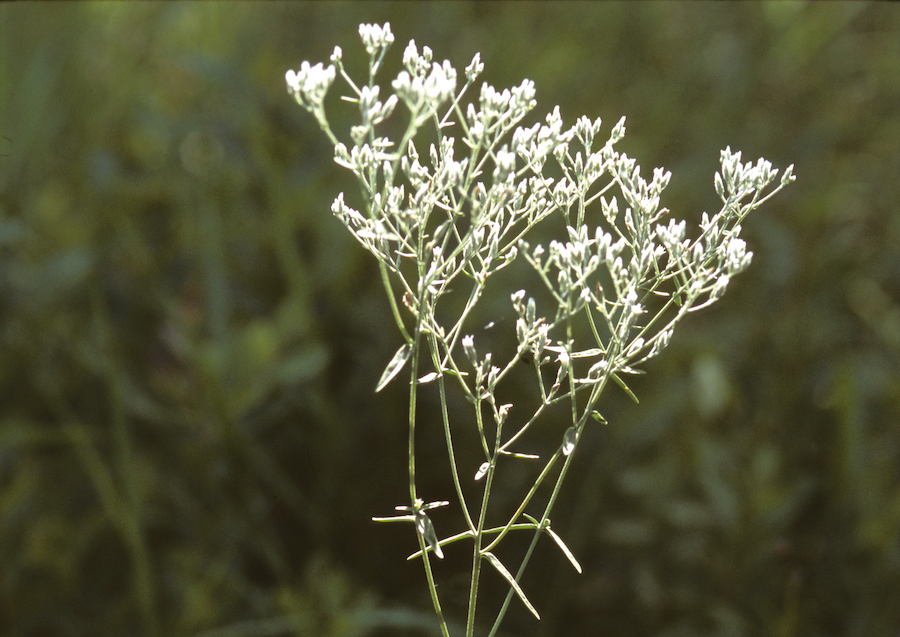
At least half of the nearly 20 thoroughworts (Eupatorium spp.) that grace Florida’s roadsides occur in the Panhandle. All have tiny white flowers borne in congested heads at the top of a branched inflorescence. Pictured: Common boneset (Eupatorium perfoliatum). Summer, Fall
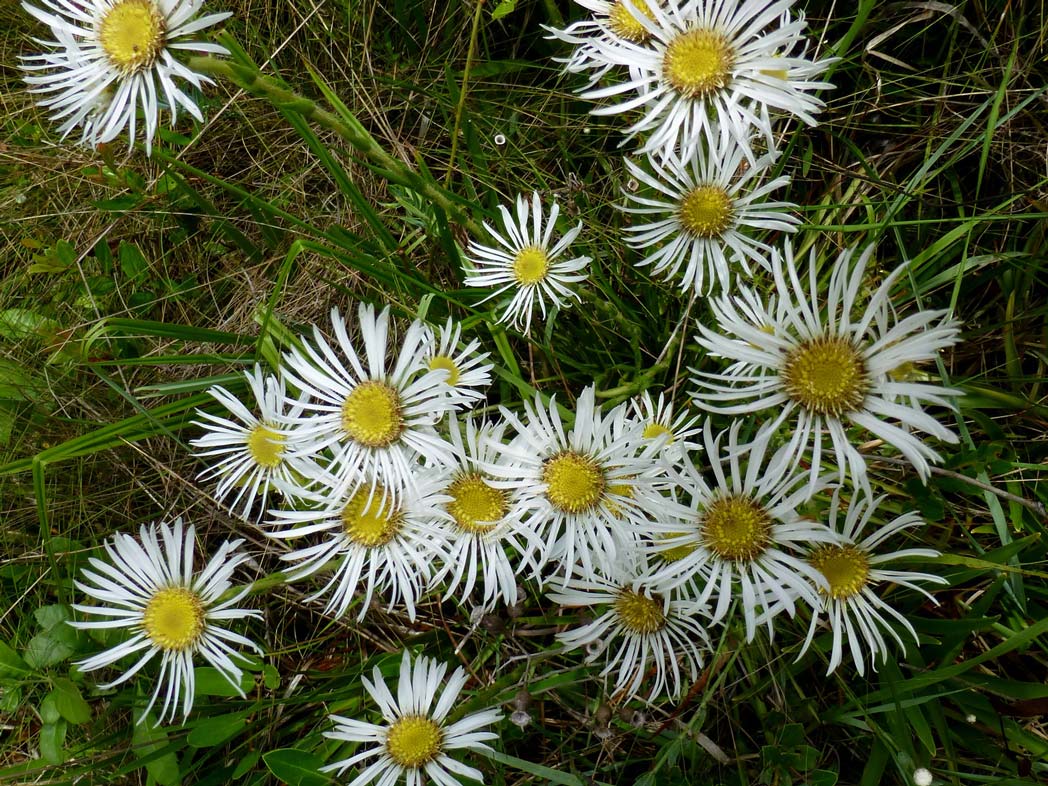
The disheveled appearance of
Thistleleaf aster (Eurybia eryngiifolia) and its thin creamy-white rays surrounding a dark-brown center sets this species apart from other asters. Its Florida range is restricted to the several counties of the central Panhandle, and it is common along roadsides in early summer, especially in the Apalachicola National Forest. Spring, Summer
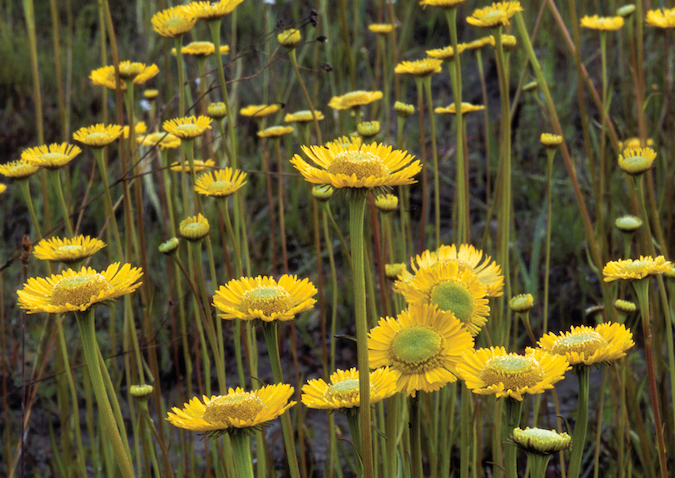
Several species of sneezeweed are found along Florida roadsides. Savanna sneezeweed (Helenium vernale), pictured, is about 3’ tall and blooms in mid-spring. It is typical of the group. At least one species flowers in summer. Spring, Summer
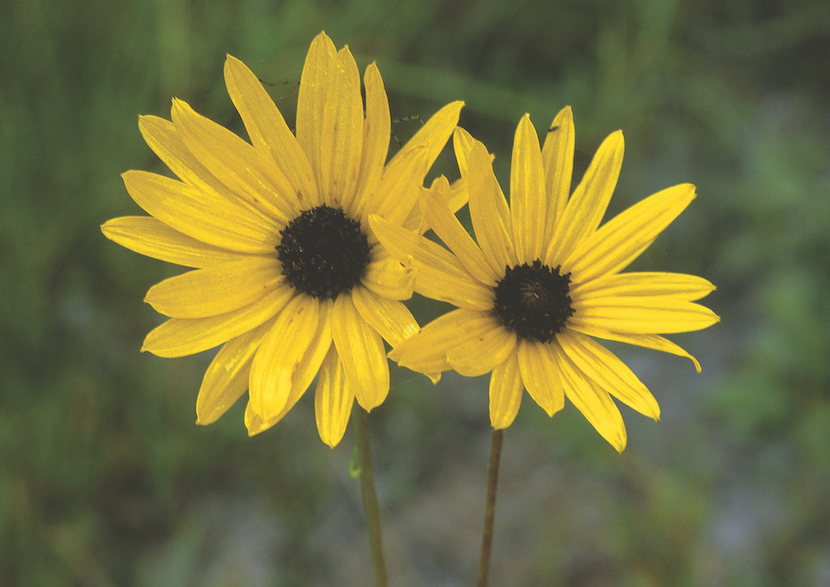
Variableleaf sunflower (Helianthus heterophyllus) is among the showiest of Florida’s fall wildflowers, decorating moist road shoulders and wet roadside ditches. The state is home to other Helianthus species, most of which have yellow petals circling a brown or yellow center. The only exception is the Rayless sunflower (pictured below). Fall
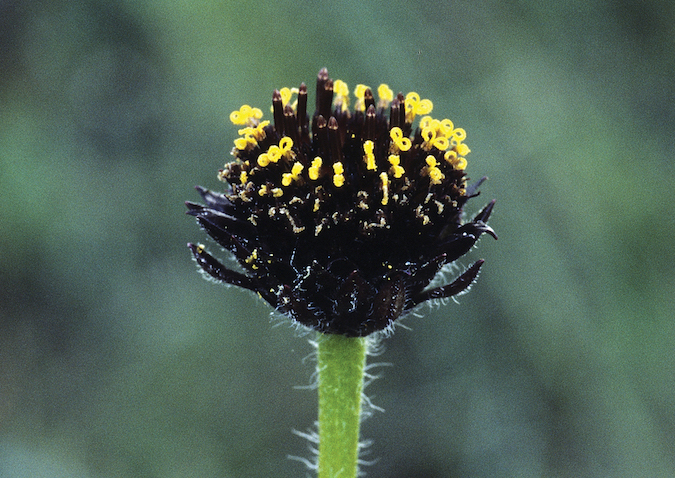
Rayless sunflower (Helianthus radula) stands in stark contrast to Florida’s other Helianthus species. Although its flowerhead lacks the bright yellow rays associated with most species, its dark brown disk more than makes up for the loss. Its sheer abundance in wet savannas and ditches ensures it won’t be missed. Fall
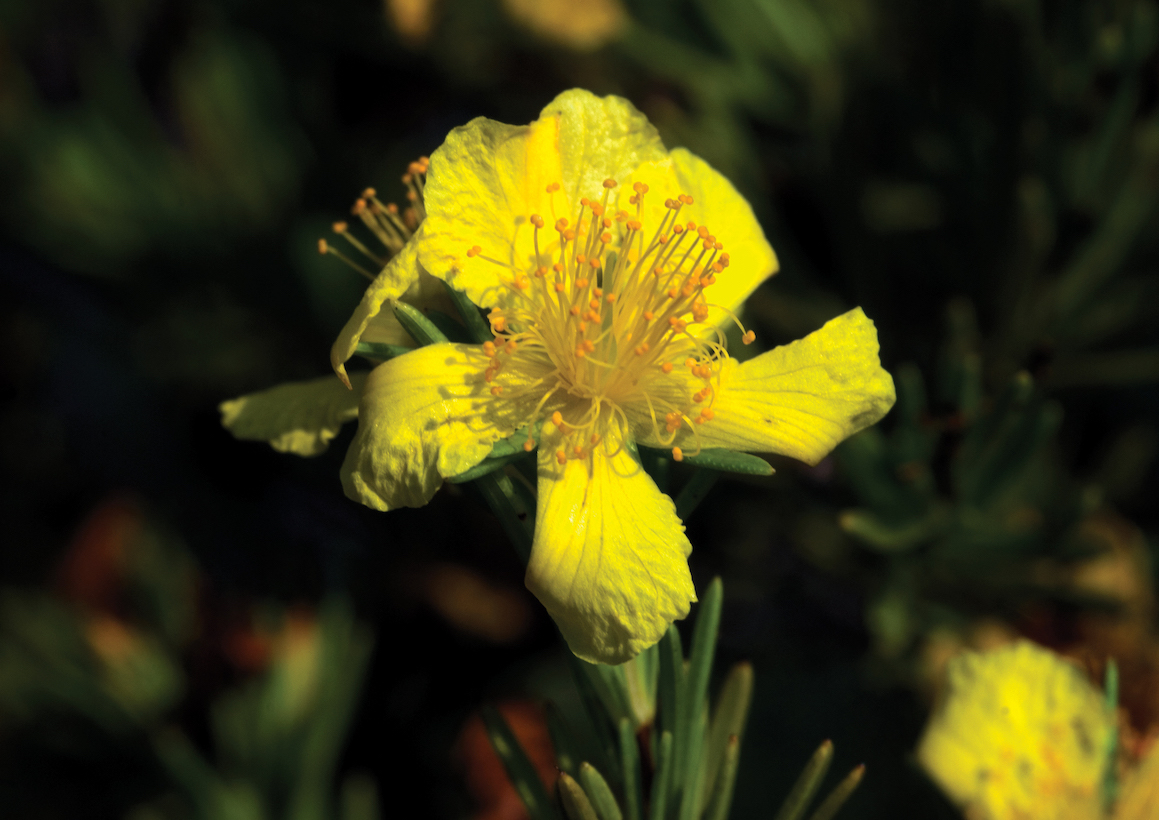
More than 20 species of St. John’s wort (Hypericum spp.) occur in the Panhandle, many along roadsides and woodland margins. All have yellow 4- or 5-petaled flowers with a brushlike mass of yellow stamens. Peelbark St. John’s wort (Hypericum fasciculatum), pictured, flowers in the spring. Spring, Summer, Fall
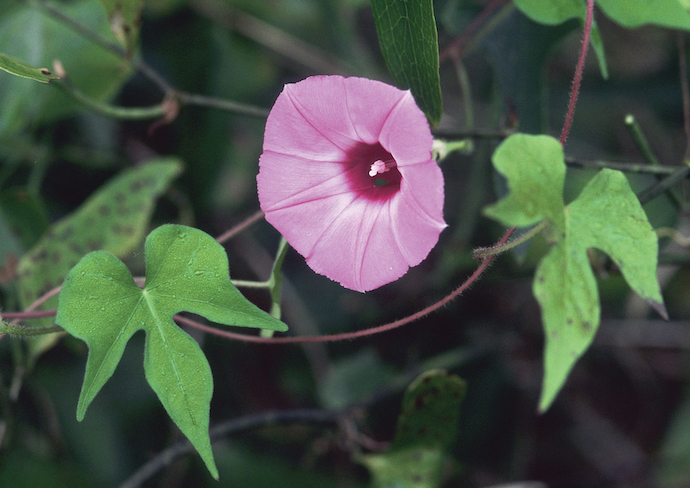
Like the showy blossoms of most morning glories, Tievine (Ipomoea cordatotriloba) flowers fade quickly as the day progresses. Its flowers are funnel-shaped, less than 2” wide, and range in color from pink to rose-purple. It is conspicuous as it scrambles over roadside vegetation in late summer and autumn. Summer, Fall
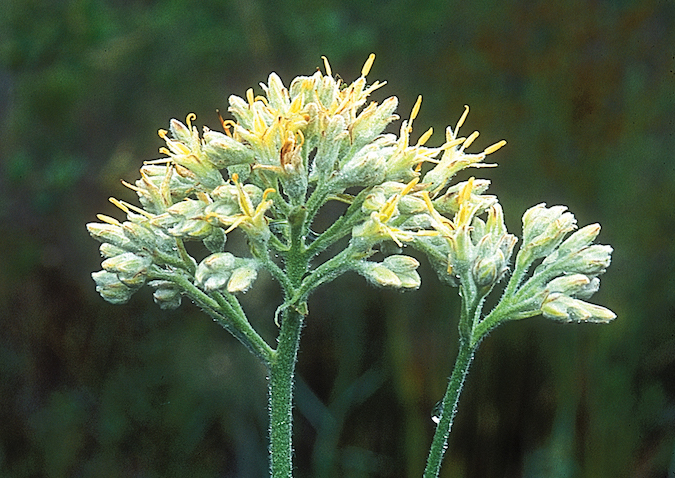
Carolina redroot (Lachnanthes caroliana) makes its appearance in late May, with its peak flowering in mid- to late June. Its 2’ stem is crowned by a white and yellow inflorescence and is very showy. Large populations of several hundred plants often occupy wet roadside ditches and are easily spotted, even at highway speed. Summer
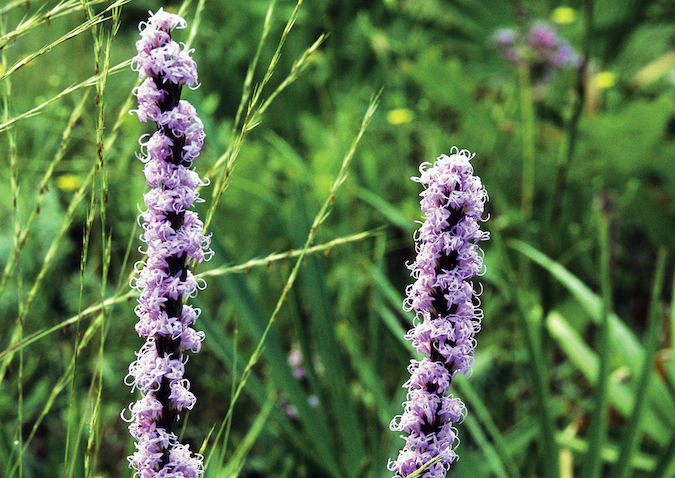
About a dozen species of blazing stars (Liatris spp.) occur in the central Panhandle, all of which have erect, spikelike inflorescences. Species vary from 2’–6’ tall and usually occur in showy colonies along moist or dry roadsides. The individual flowers are small, 5-lobed, and star-shaped, which explains the common name. Pictured: Chapman’s blazing star (Liatris chapmanii). Summer, Fall
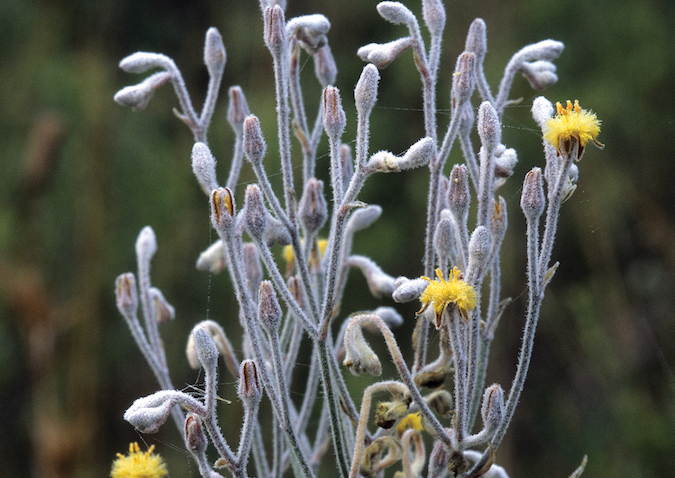
Golden crest (Lophiola aurea) is a wetland-loving herb that stands 1’–3’ tall and prefers savannas and wet ditches. The whitish, hairy stem supports a branching inflorescence. The scientific epithet aurea means golden, a fitting description of the flower color. Spring, Summer, Fall
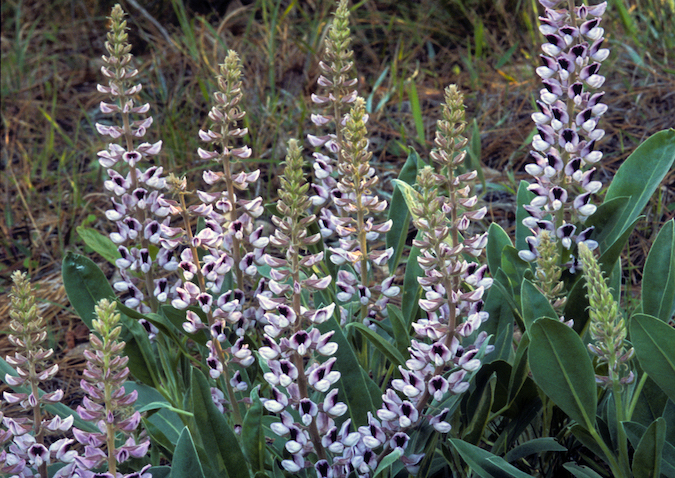
Lady lupine (Lupinus villosus) is one of the more common of our native lupines. The dense cluster of hairy, blue-gray leaves and erect 1’–2’ spikes of lavender to pinkish flowers make a conspicuous display along dry, sandy roadsides. Spring
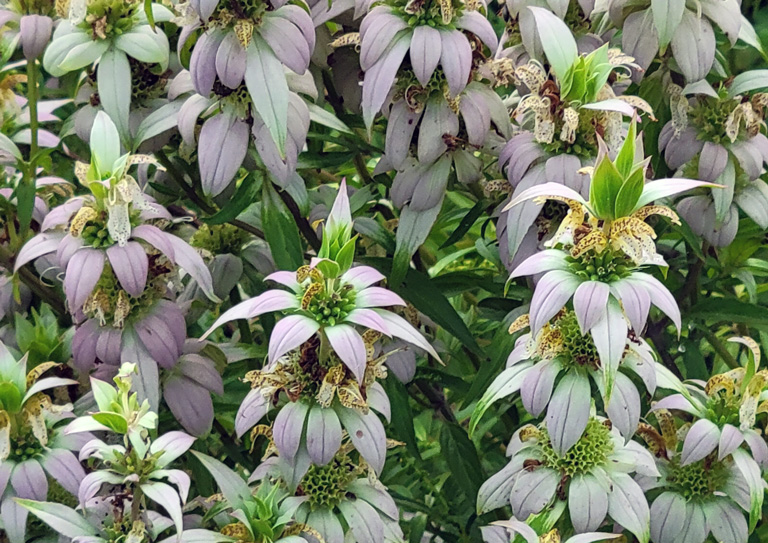
Dotted horsemint (Monarda punctata) is worth stopping for. The large purplish-pink bracts and spotted yellow flowers are exquisite when seen close up, and the minty aroma only adds to the sensory appeal. Handling any part of the plant can impart a pleasing fragrance to the skin. Fall
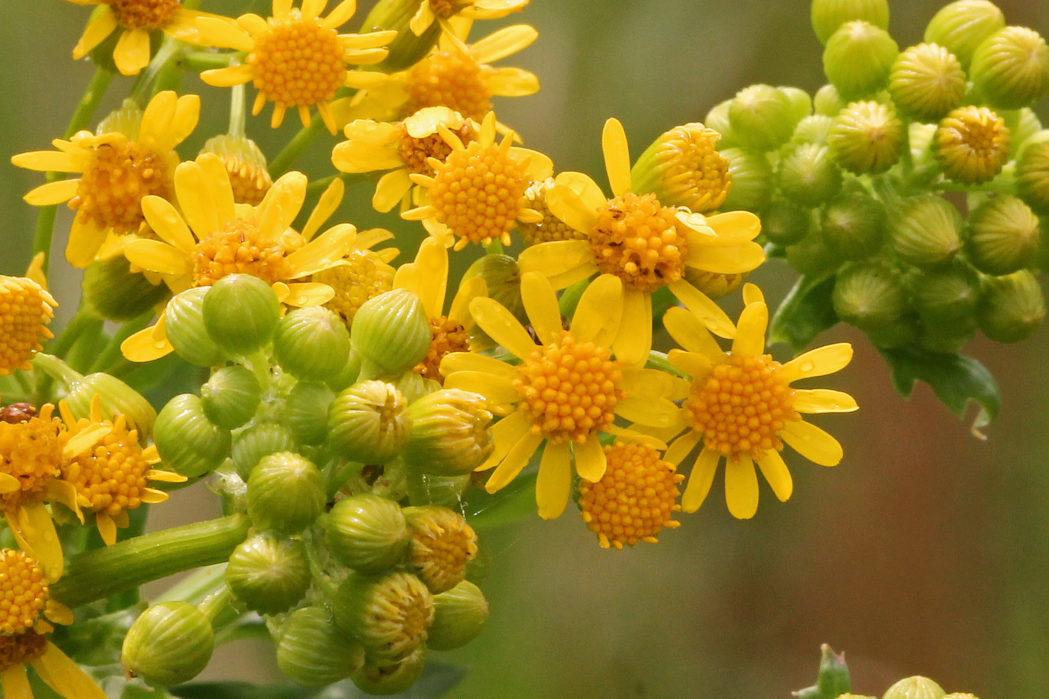
Butterweed (Packera glabella) is one of our earliest blooming native wildflowers, sometimes flowering as early as January. It stands about 2’ tall and prefers low roadsides and wet ditches. The golden flowers and deeply divided leaves are distinctive. Spring
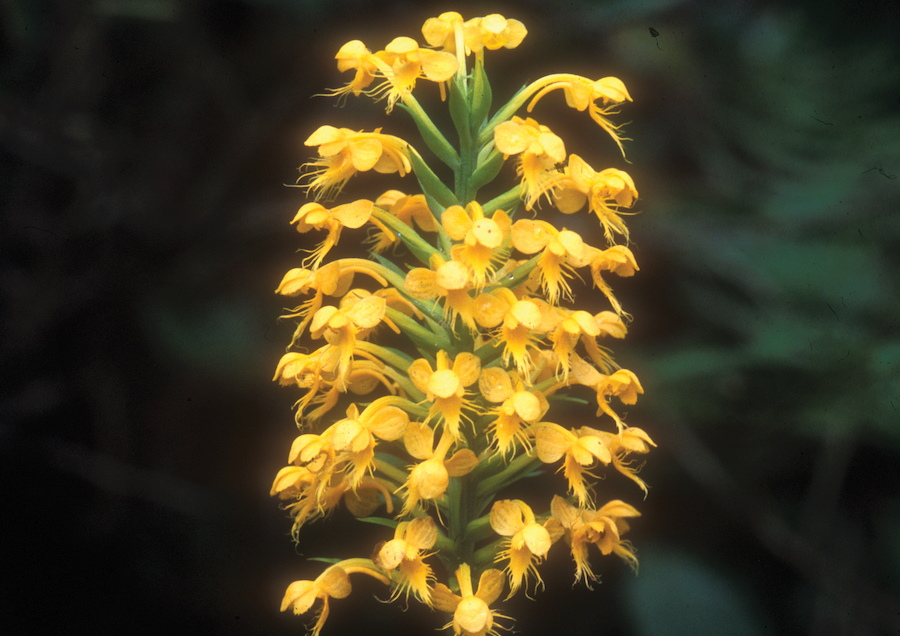
Several fringed and fringeless orchids (Platanthera spp.) can be found along moist or boggy roadsides, especially in the Apalachicola National Forest. The flower color of these upright, 1’–3’ tall plants ranges from bright white to yellow or orange. Blooming begins in June for white-flowered forms, with a succession of oranges and yellows from mid-July into August. Pictured: Crested fringed orchid (Platanthera cristata). Summer
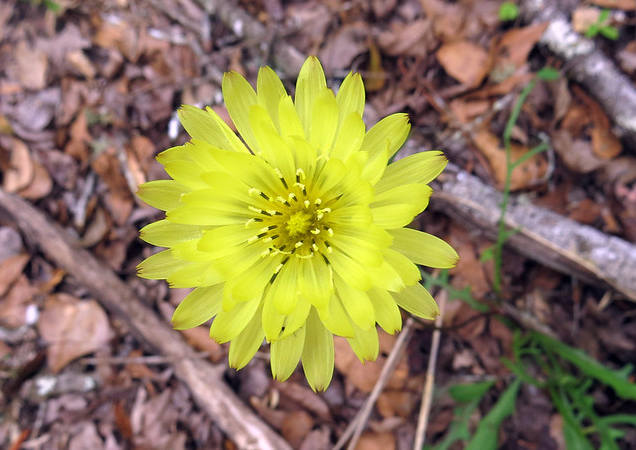
Carolina desert chicory (Pyrrhopappus carolinianus) is a yellow-flowered member of the Aster family. It begins blooming as early as February and continues throughout the spring, even into mid-summer. Its slender stem is about 2’ tall and is terminated by a dense head consisting only of soft yellow ray flowers. Unlike the Black-eyed Susan and most other species in this family, the flowerhead lacks a central disk. Spring, Summer
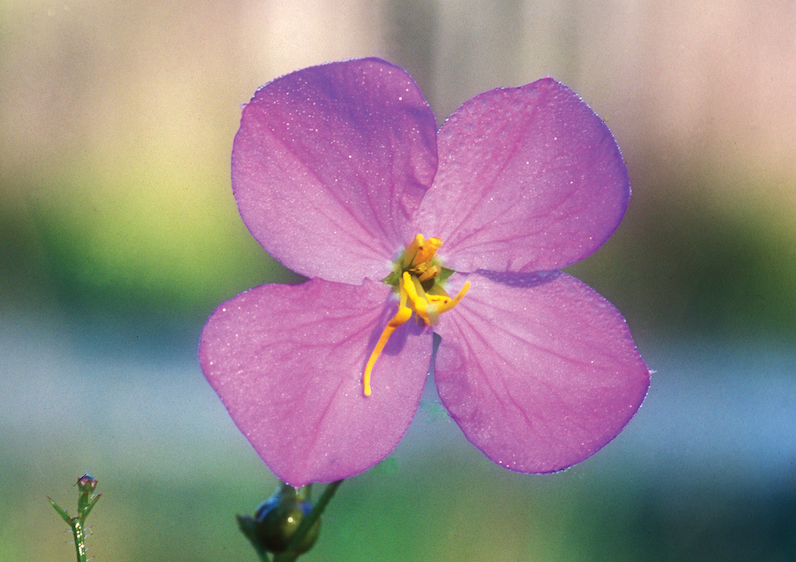
As their name suggests, meadowbeauties (Rhexia spp.) prefer treeless savannas, open bogs and sunny roadsides. There are about a dozen species, most of which have pink or purple flowers with large yellow hooklike anthers. They are one of our most abundant groups of summer-blooming wildflowers. Pictured: Nash’s meadowbeauty (Rhexia nashii). Summer
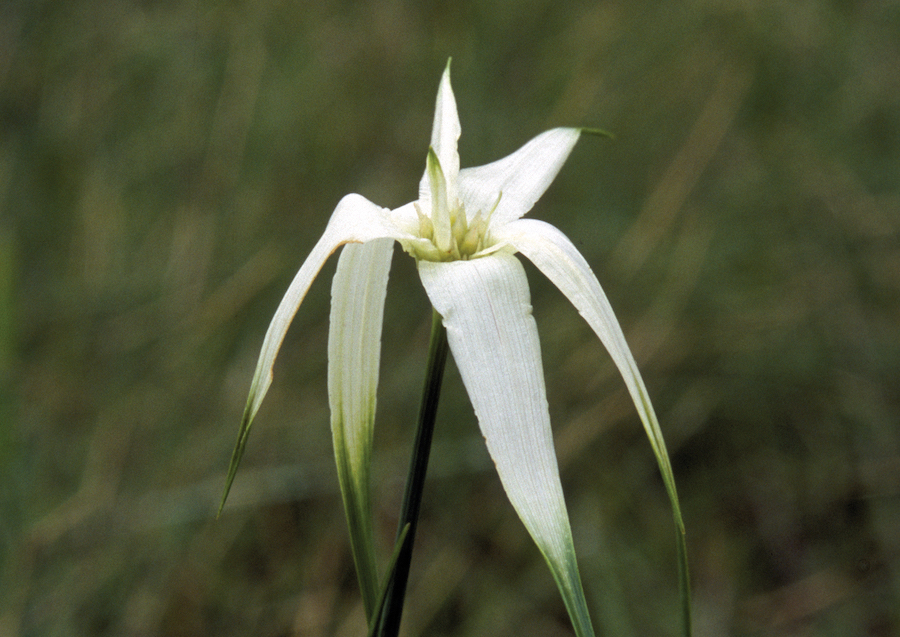
Not many sedges make the list of showy bloomers. Giant whitetop (Rhynchospora latifolia), pictured, is one of two species of whitetop sedge that are the exceptions. The white structures below the flowers are actually leaflike bracts, but their effect is that of flower petals. Spring, Summer
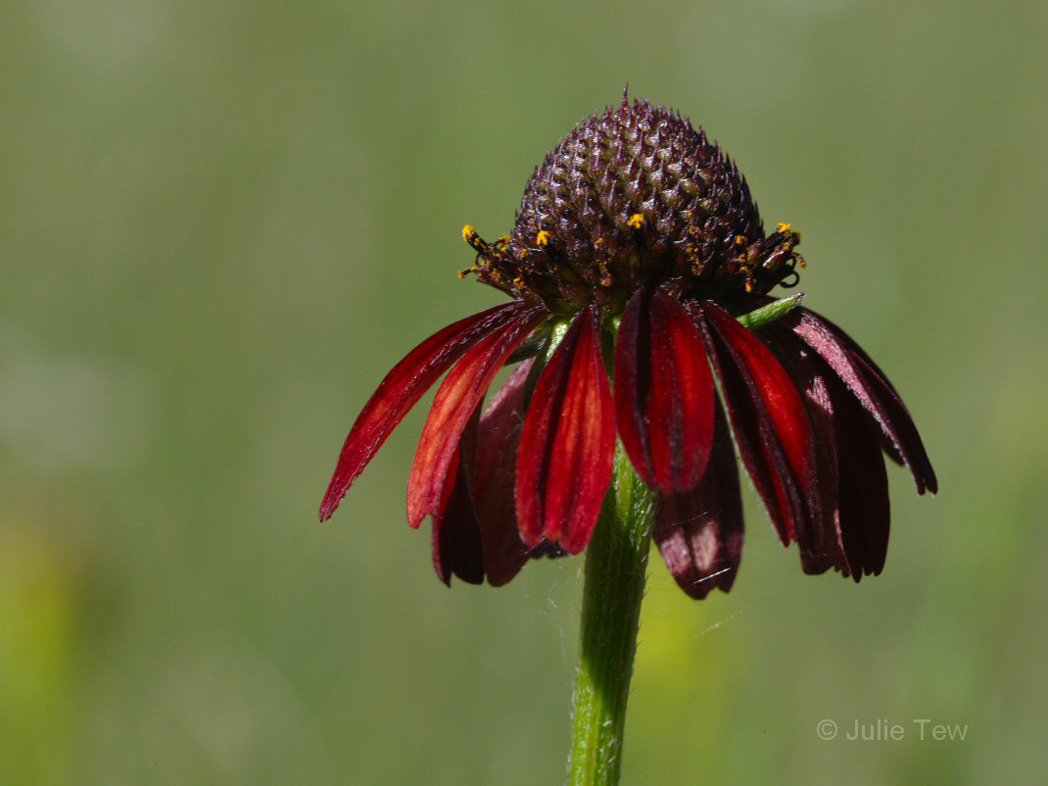
The combination of short brick-red rays and large conelike disk sets Grassleaf coneflower (Rudbeckia graminifolia) apart. It can be abundant in savannas and on moist roadsides, where hundreds of the 2’ stems can dot the landscape, each topped with a single flowerhead. Summer
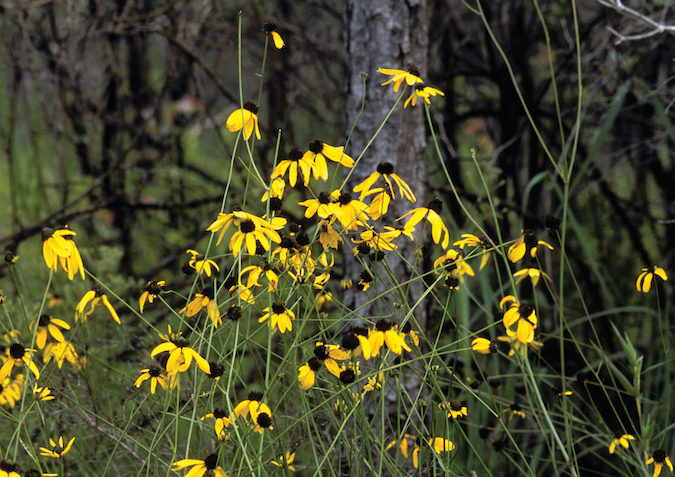
Several of our roadside Rudbeckia species are immediately recognizable from their resemblance to garden plants of the same name. Most have a central conelike head surrounded by numerous yellow rays. Mohr’s coneflower (Rudbeckia mohrii) is one of our showiest examples. Summer
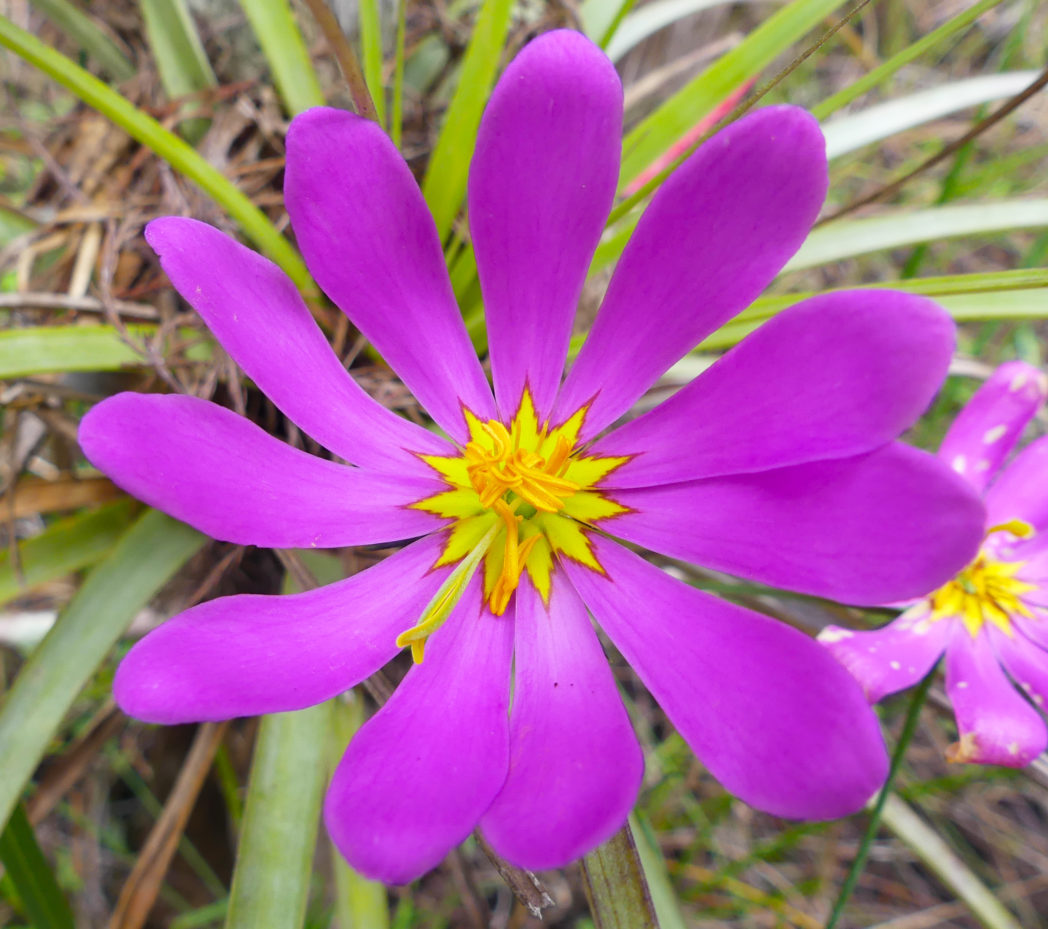
Rosegentians (Sabatia spp.) are summer delights. About a dozen species occur in the Panhandle, some with white flowers, others with pink flowers. Roadside species usually have five or 10 petals. Bartram’s rosegentian (Sabatia decandra), pictured, is bright pink with 10 petals. Summer
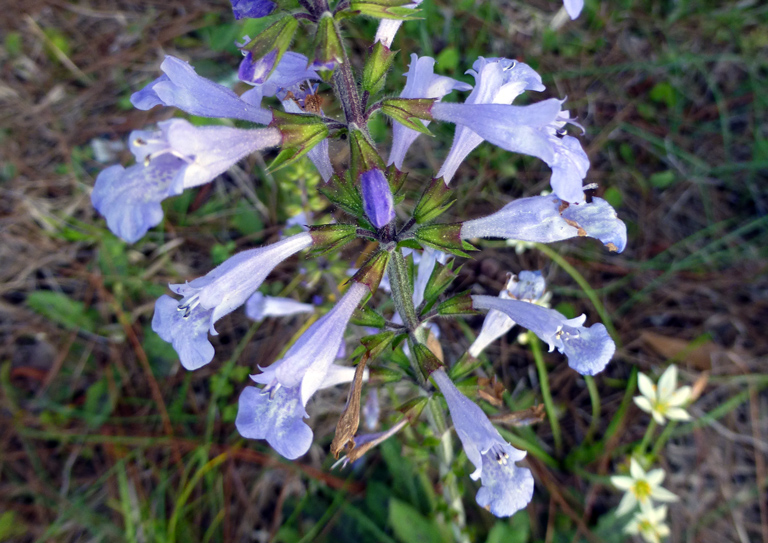
The lavender-blue flowers of Lyreleaf sage (Salvia lyrata) often dominate early spring roadsides. Plants average 1’–2’ tall with a single upright stalk and a whorl-like cluster of ground-hugging leaves. Spring
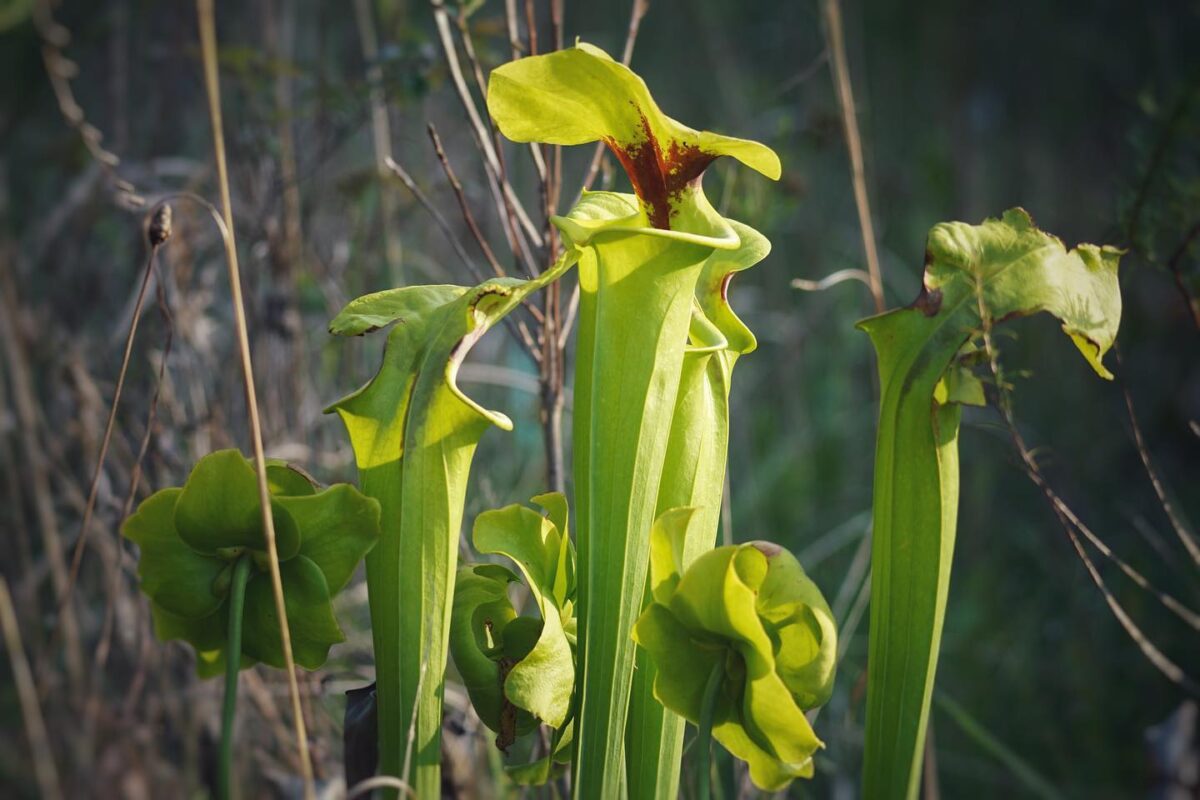
Northwest Florida is well known for its assortment of insectivorous pitcherplants (Sarracenia spp.), at least four of which can be seen along our recommended roadsides. The trumpet-like leaves of the Yellow pitcherplant (Sarracenia flava), shown here, can be 2’ tall. All can be seen along wet to moist roadsides, especially along SR 65 and the Apalachee Savannas Scenic Byway. Spring, Summer
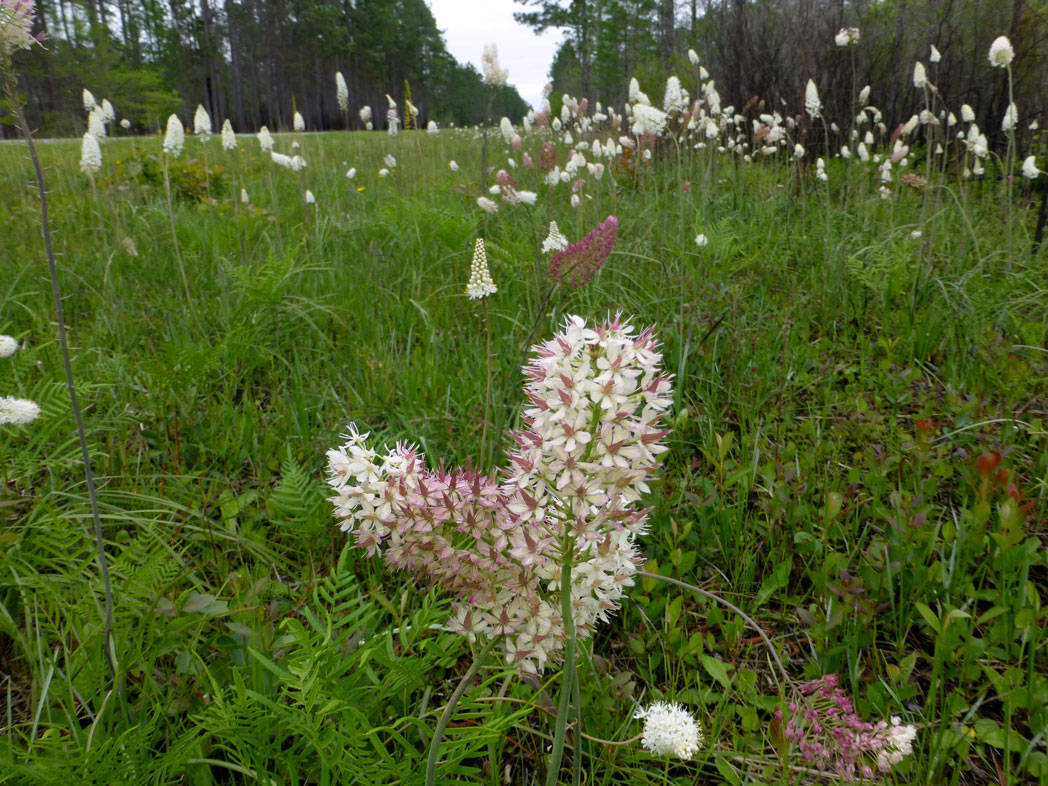
Natural and prescribed fire is a well-known wildflower catalyst. This is certainly true of Crowpoison (Stenanthium densum), which sends up its slender 3’ stems and cone-shaped inflorescences within days or weeks following a growing-season burn. The small individual flowers start out white, but turn purplish as they age. Spring
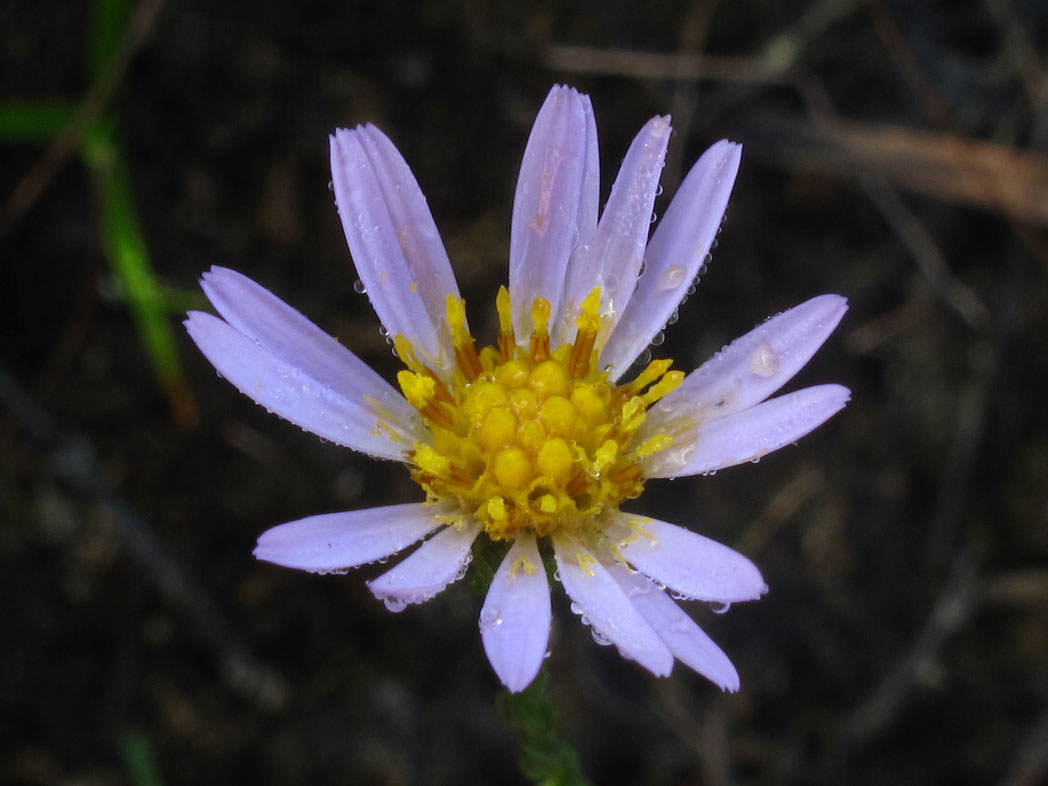
Scaleleaf aster (Symphyotrichum adnatum) is one of several blue-flowered asters found along Panhandle roadsides. It is a low-growing species with tiny, awl-shaped leaves that point upward and tightly hug the stem. Chapman’s aster (Symphyotrichum chapmanii) has similar flowers but grows much taller, with a slender arching stem that is nearly devoid of leaves. Spring, Summer, Fall
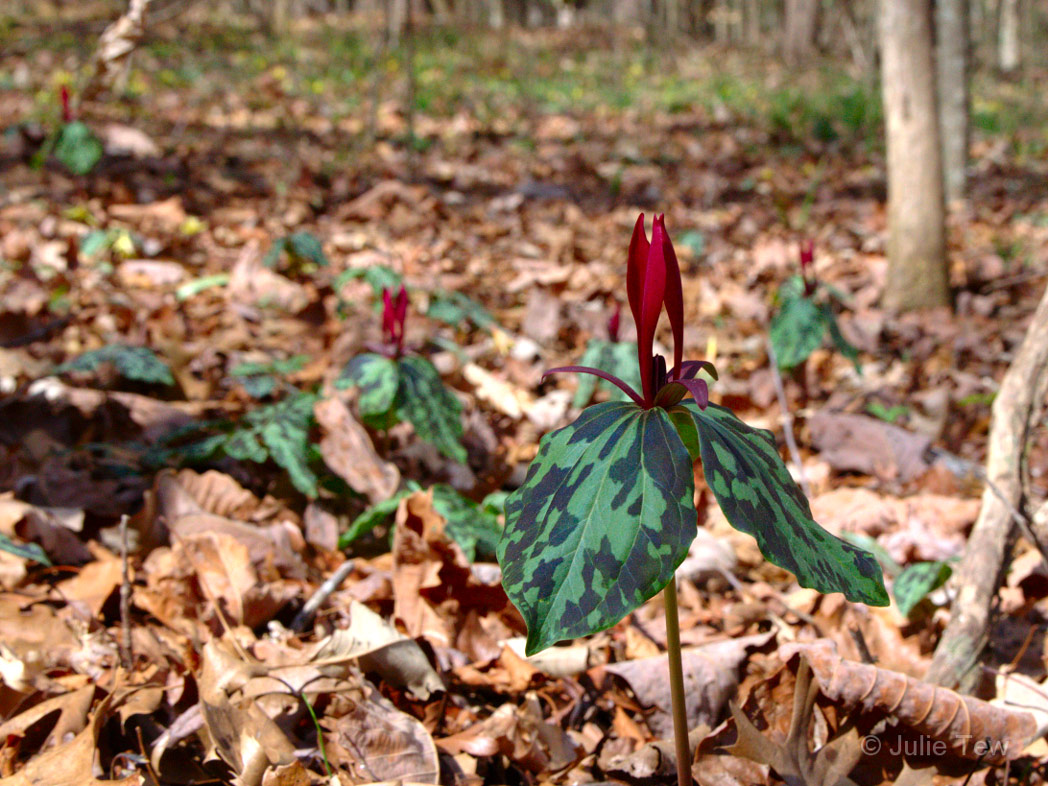
You’ll have to find a shady hardwood forest to see our native wakerobins (Trillium spp.). The leaves of these long-lived perennials make their annual appearance in late winter and flower in early spring, well before the trees put on new leaves. Chattahoochee Nature Park, Torreya State Park and Jackson Mounds are good destinations to search for these interesting plants. Spring
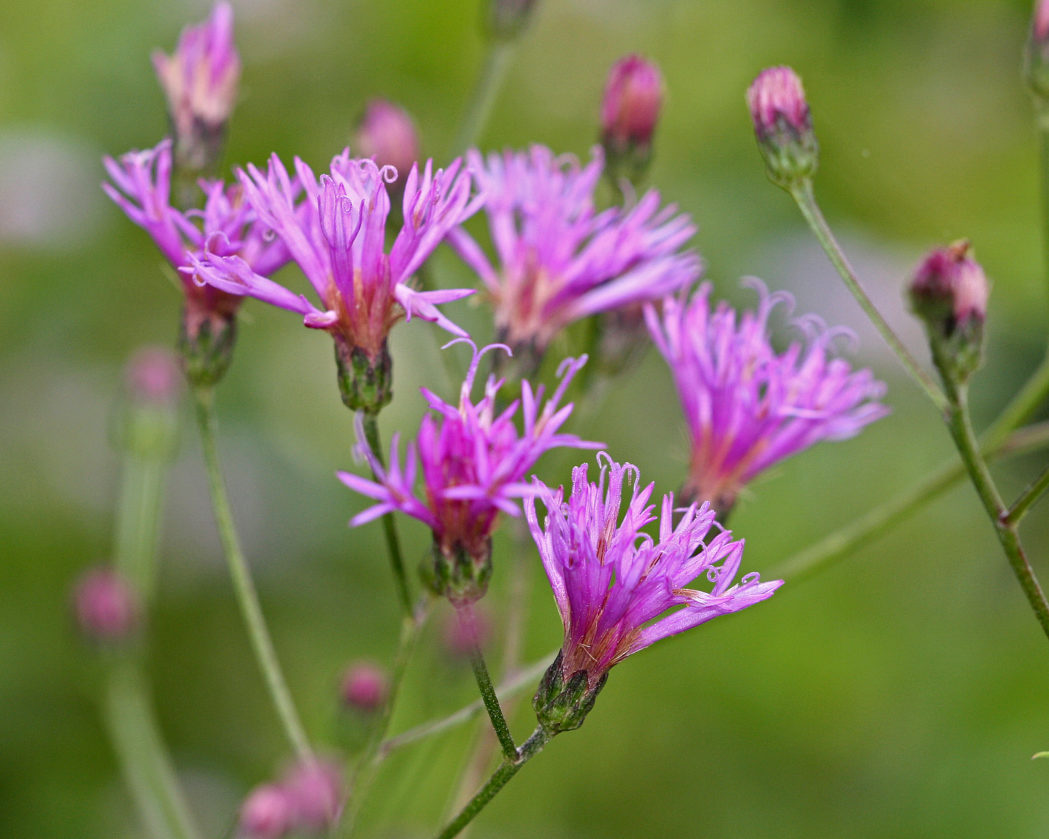
Ironweeds (Vernonia spp.) are tall, wispy plants with striking purple flowers and an upright form. Plants average 3’–5’ tall, usually with several upright stems. Some prefer dry sites, others moist roadsides. Fall
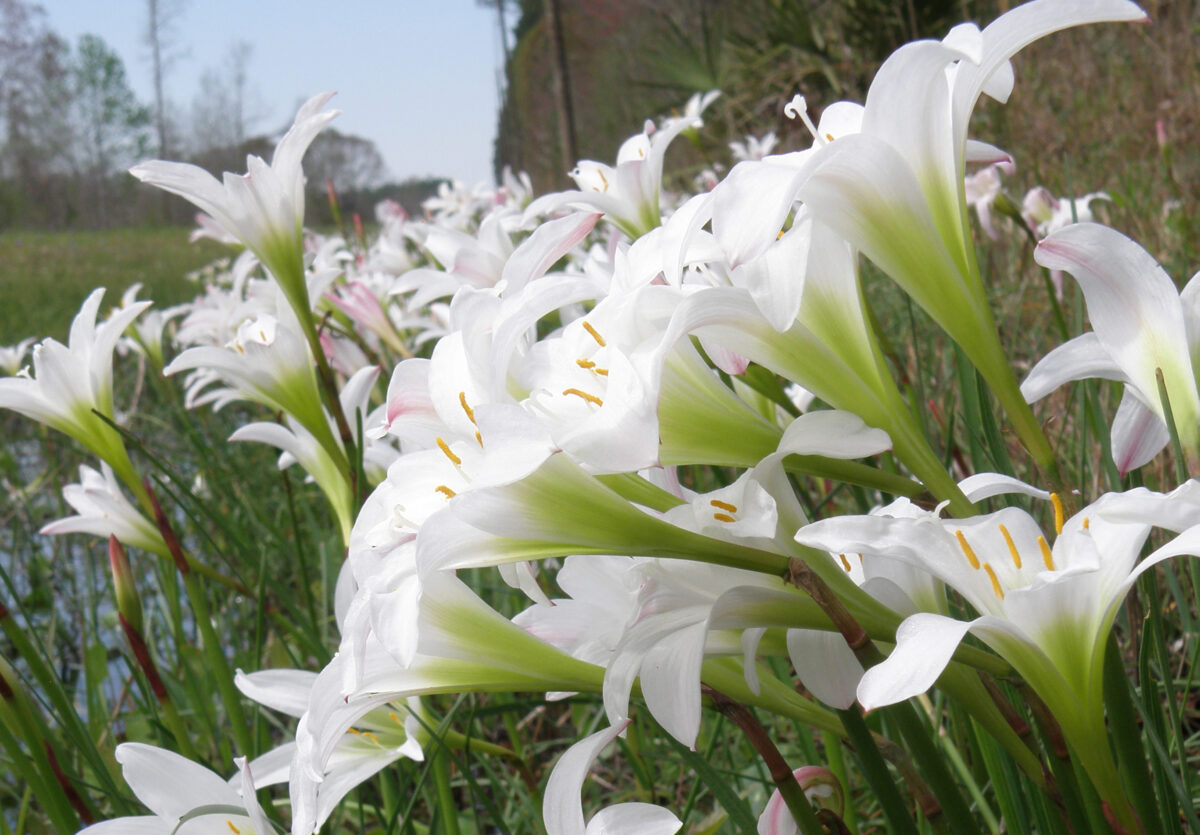
Rainlilies (Zephyranthes spp.) often flower immediately following a downpour. Two similar species occur in the Panhandle. Both have shiny green grasslike leaves and white trumpet-shaped flowers. One species grows along the margins of moist roadside ditches, the other mostly in shady hardwood forests. Spring

